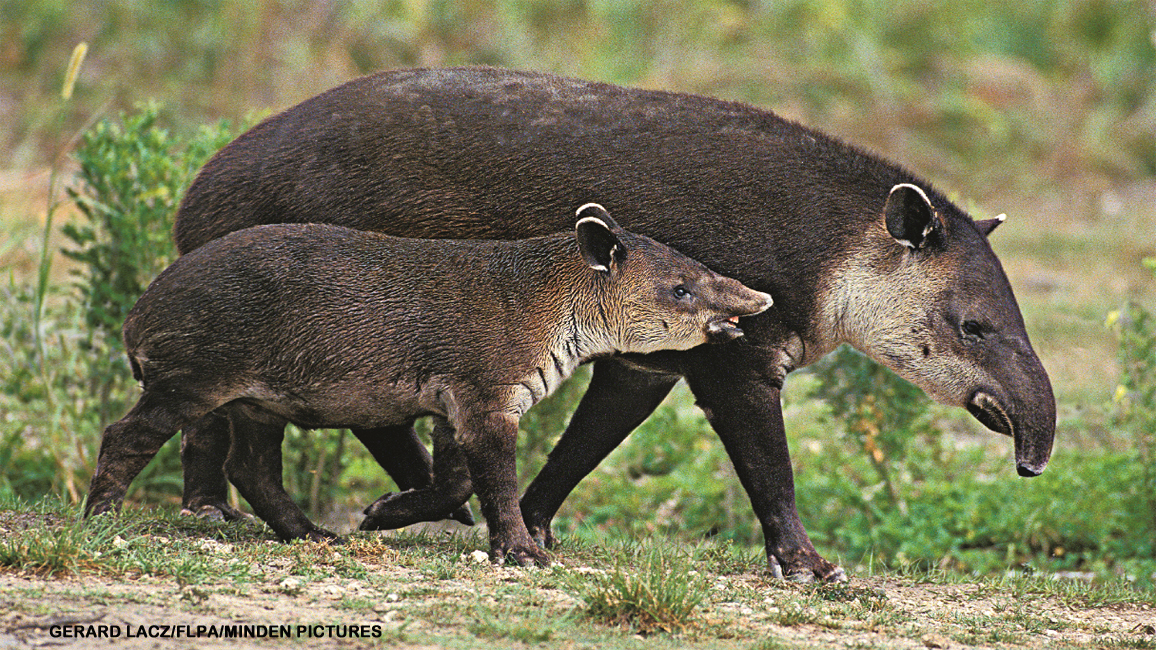
Tapirs: The Forest Gardeners
By Tiana Tapir, as told to Anne CisselFor millions of years, we’ve helped the jungle stay in tip-top shape.

I’ll bet you’re looking at the photo above and wondering, “What is that? An elephant with a stubby trunk? An anteater? Some sort of long-nosed pig?” No, it’s a tapir (TAYpur)—a Baird’s tapir, to be exact. Still confused? Don’t worry. My name is Tiana Tapir, and I’m a Baird’s tapir. I’ll tell you the whole story!
My mom and I live in a Central American forest. Most tapirs hang out in tropical forests, usually by themselves. There are three other species of tapirs, which live in other parts of the world (see map on page 20). All tapirs are mammals, and—believe it or not—one of our closest relatives is the rhinoceros. Scientists think of us as “living fossils” because we’ve looked pretty much the same for millions of years. But why do people also call us “forest gardeners”? Let’s find out!

FOREST FOOD
Maybe what you noticed first is that long snout. It’s called a proboscis (pruh-BOSS-iss). It’s a combination of an upper lip and a nose. Like an elephant’s trunk, it’s very bendy and moves in all directions, sniffing for food. It helps us to reach high-up plants. I can also use my proboscis as a snorkel when I go for a swim. And sometimes Mom nudges me with hers to guide me toward good food to eat.
A Baird’s tapir can grow to be six feet long and more than 500 pounds. We are the largest land mammals in this part of the world. We spend a lot of time eating, zigzagging through the forest on the same trails our relatives have used for years. Nighttime is our favorite time to look for food, because it’s nice and cool then. We love munching on leaves and fruits. In fact, we eat more than 200 different kinds of plants.
We get the name “forest gardener” because our poop is full of the seeds from those plants. All kinds of plants sprout up from the poop, which helps the rainforest grow. So the forest stays healthy just from us doing our daily business!
We don’t have many enemies because we are so big and our skin is tough. But a large crocodile or jaguar could spell big trouble, especially for babies. As a newborn, I had a reddish-brown coat with white spots and stripes. Enemies had trouble seeing me in the patchy light of the forest floor. But now that I’m six months old, my “grown-up” coat has completely grown in.
➡️VIDEO: WATCH TAPIRS MUNCHING IN THE FOREST!

MEET THE COUSINS
In South America, there are two other species of tapirs: the South American tapir and the mountain tapir. The South American tapir looks a lot like the Baird’s tapir, but it is slightly smaller and usually lighter-colored. It also has a stiff mane that goes from its forehead to its shoulders. The mountain tapir is the smallest kind of tapir. Temperatures at night in its mountain home can drop to below freezing. Its thick coat keeps it warm. Far away in Southeast Asia is the Malayan tapir. This tapir’s hair is black with a large white patch on its back and belly. It is the biggest of the four tapirs.
SAVE THE TAPIRS!
Sadly, my cousins and I are in trouble. There were twice as many Baird’s tapirs 30 years ago as there are today. People hunt us and tear down the forests where we live. All four tapir species are threatened. This is not only bad for us, but bad for the forests, too.
Groups are working hard to protect the places where tapirs live and to stop all illegal hunting. Tapir scientists hope that, by teaching local people about us, they will work to protect us, too. Now that YOU know about us, I bet you’ll agree—tapirs are terrific
















